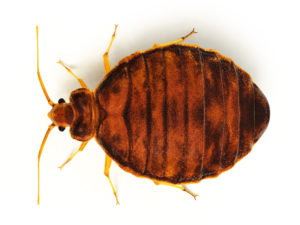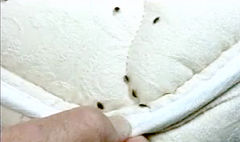It’s two in the morning and I finally find a hotel with a vacancy. I just completed a 12 hour mud race, so I’m ready for a shower and a long rest. As I step into the shower, an all too familiar shape catches my eye. A direct look confirms: bed bug. As a pest professional, I know to capture that bug, get a refund and sleep in the car, but I have the luxury of knowing bed bugs and the treatment process. So we are all as prepared, let’s dive into understanding bed bug treatment.
The Target
The first part of understanding bed bug treatment is understanding the target. Bed bugs are:
- small in size (think watermelon seed for adults), but visible
- master hitchhikers. They can make their way from building A to your home via shoe tread, suitcase seems, coat pocket, etc.
- gradual metamorphosis developers. They go from egg to nymph (nymphal stages referred to as instars), to adult.
- master adapters. They have shown great ability to develop resistance to chemicals
- traumatic inception reproducers. The female is stabbed in the abdomen by the male’s organ, so she is likely to run off and find a place to hide and protect herself. This can lead to bed bugs spreading in unpredictable ways and areas.
Inspections
The first part of any bed bug treatment is a solid inspection. Inspectors include both the human and canine variety. Each has its advantages and disadvantages. The main point is to confirm the presence of bed bugs. This may be finding an adult or nymph, locating egg deposits, or finding bed bug fecal matter. Oftentimes, the fecal matter will tell the story of the paths traveled and the congregation centers. A good inspection will be able to give an idea as to what needs discarded, what needs treated, and what process will be most effective.
Preparation
Between the inspection and the treatment, the pest professional should advise you on proper preparation. This will typically be an extensive list but will be your guide in helping the treatment be as successful as possible. It typically includes bagging and laundering all clothing possible ensuring a thorough drying on high heat. Other things will include moving treatment sensitive items such as medications, crayons, paintings, etc. to either the fridge or a predetermined inspection area.
Application methods
There are multiple ways to treat bed bugs. Oftentimes, it is best to use multiple methods in combination to ensure success on the first attempt.
Cold
Bed bugs are susceptible to death in all stages at extreme temperatures. This doesn’t mean the best plan is to open all the windows and doors and turn the heat off in a Minnesota winter. You would likely end up with burst pipes, water damage, and still, have bed bugs. This method is typically done on a large scale with cryogenic freezing. This method requires a special applicator to apply the cold in a way that will penetrate into mattresses, wall voids, and other cracks and crevices where bed bugs may be hiding out.
Chemical
There are many products available for killing bed bugs. It is important to follow label instructions carefully for both safety and legal reasons. The extensiveness of a chemical application will depend on both the level of activity as well as if it includes other treatment methods. The idea is to get the product as close to the bed bugs paths and hiding places as possible without having regular human exposure to the product. Chemical application tools include compressed sprayers, aerosol applicators, foggers, etc.
Heat
Heat treatments can be on a small scale where individual items are heated through to a lethal temperature for all bed bug life stages. This may include books, clothing (often in a dryer), individual pieces of furniture, etc.
Large scale treatments can be heating entire rooms or buildings to a lethal temperature for bed bugs. These are typically long treatments that may take all day or multiple days, but when combined with other control methods, they can control even large infestations in a matter of hours.
Mechanical
Mechanical controls involve physical alterations that combat bed bugs such as:
- Pit Falls – small traps that can be placed under bed legs to stop bugs from being able to travel up onto the bed from the ground.
- Garbage – Some items either contain too large of a population or too much fecal matter to keep. It is important to dispose of these items in a way that will not spread bugs to other dwellings.
- Encasements – bed bug proof encasements made for box springs, mattresses, couches, etc. that stop bugs from going in or out.
Zombie Bugs
Heat, chemical, and freezing can all produce zombie bugs. These are bed bugs damaged to the point where they can no longer reproduce or feed. These bugs typically alarm those who have received treatment but should be carefully considered before determining whether additional treatment is needed.
Consultation
Whether you suspect or know bed bugs need resolving, don’t hesitate to reach out to our Bed Bug Specialists at Rove Pest Control. Understanding bed bug treatment is simplified with an expert guide. We can review your specific situation and help you understand the pieces that are pertinent to you and your home. Keep it simple. We take care of the bugs so you can sleep tight and legitimately not let the bed bugs bite.


